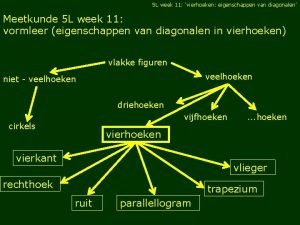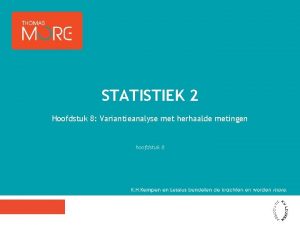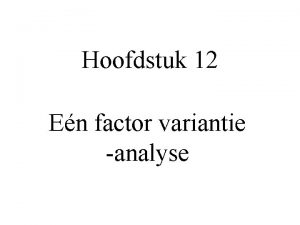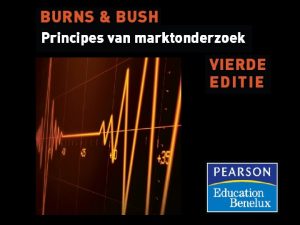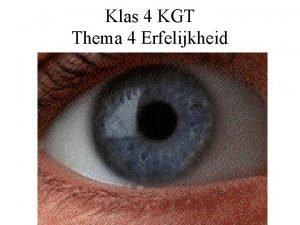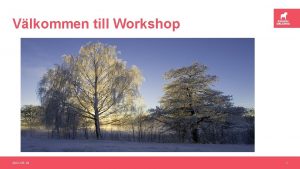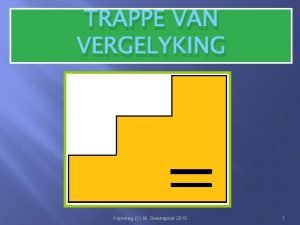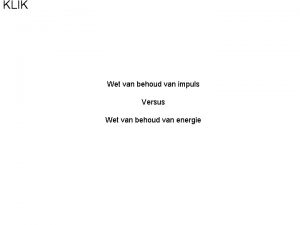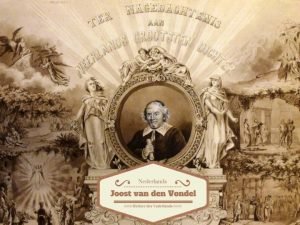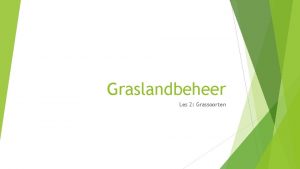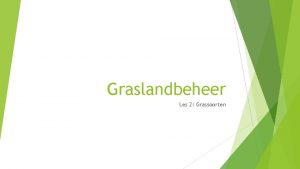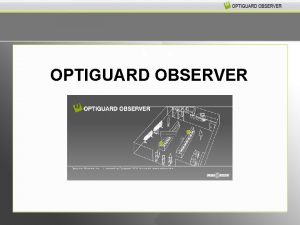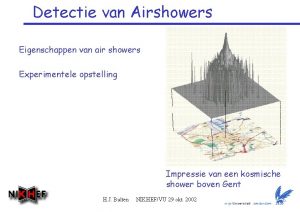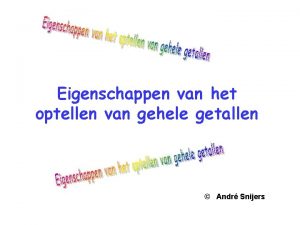Perceptieeffecten van geografische variantie in microprosodische eigenschappen Marie















- Slides: 15

Perceptie-effecten van geografische variantie in (micro-)prosodische eigenschappen Marie Nilsenová Communicatie- en informatie Wetenschappen Faculteit Geesteswetenschappen Universiteit van Tilburg

Background • Clear correlation between age, body size and F 0, as well as timbre (Greisbach 1999, Kraus, Freyberg & Morsella 2002) • Listeners should be able to exploit that knowledge, eg reflecting on the Frequency Code: deeper <-> bigger/taller • But listener estimates not as good as could be expected, also correlation not always perfect (Cohen et al 1980, Gunter & Manning 1982, van Dommelen & Moxness 1995) • Free (non-linguistic) variation with social, geographical distribution? • Expectation: listeners should perform better when estimating speakers in their own variant compared to another variant

Methodology • 16 speakers (8 male, 8 female/8 B-Dutch, 8 B-Flemish) reading the same short text (newspaper article) • 2 groups of participants - Dutch, Flemish • Task: estimate speaker’s length, weight, age and the ‘pleasantness’ of the voice (operationalized as 3 properties; Cronbach’s >. 65); fixed time • Also report if speaker Dutch or Flemish

Speaker comparison: Female Age (years) Weight (kg) Length (cm) NL-fem-1 25 65 173 NL-fem-2 40 60 174 NL-fem-3 57 63 163 NL-fem-4 56 65 178 VL-fem-1 38 60 169 VL-fem-2 31 68 180 VL-fem-3 34 56 163 VL-fem-4 36 56 169

Speaker comparison: Male Age (years) Weight (kg) Length (cm) NL-masc-1 41 88 184 NL-masc-2 34 72 184 NL-masc-3 29 83 190 NL-masc-4 25 83 174 VL-masc-1 32 79 185 VL-masc-2 41 65 180 VL-masc-3 28 78 188 VL-masc-4 37 63 168

Questionnaire • Wat vindt u van deze stem? Plezierig Vriendelijk Aangenaam Wat is volgens u de leeftijd van de spreker? Wat is volgens u de lengte van de spreker? Wat is volgens u het gewicht van de spreker? De spreker is Vlaams Nederlands Onplezierig Onvriendelijk Vervelend jaar cm kg

Design • Two conditions: normal and reversed speech (Audacity) • Purpose of the reversed speech condition: – to assure that speakers do not adapt to the variant they hear based on previous experience; – also, to examine if adaptation to own variant also relevant for perception of an ‘unknown’ language

Participants (N=179) Dutch Flemish Total Normal speech condition Reversed speech condition Male 10 27 Female 25 41 Male 9 13 Female 18 36 62 117

Measure of accuracy • Index of accuracy (Kraus, Freyberg & Morsella 2002): the average of the absolute difference between estimated and actual values (AD) - the mean of the absolute differences between judges’ estimates of speakers’ values on an attribute and the speakers’ actual value • The AD measure indexes judges’ average error in estimating a particular attribute • It answers the question “How close is the average estimate of attribute X to the actual value of X? ” • Absolute accuracy - the sum of the absolute difference between estimated and actual values (AA)

Results (Length) • Normal condition (AD): interaction effect between speakers’ variant and gender, and listeners’ variant (p<. 05, partial eta squared =. 127) in the predicted direction • Reversed condition (AD): main effect of speakers’ variant (p<. 05, partial eta squared =. 058): Dutch speakers estimated more accurately than Flemish speakers



Results (Pleasantness) • Normal speech condition: interaction effect of speaker’s variant and listener’s variant (p<. 01, partial eta squared =. 135) listeners prefered their own variant • Reversed speech condition: clear main effect of speaker’s variant (p<. 001, partial eta squared =. 535) - reversed Flemish prefered to reversed Dutch

Conclusion • Accuracy of length estimation higher in normal speech condition for own variant • Result not translated into the reversed speech condition • Clear preference for speakers of own variant • Listeners generally reported that estimating weight difficult • Other measures of accuracy to explore the directions of the accuracy judgments

Thanks to: Hanne Kloots Machiel Debets Julia Hirschberg Marc Swerts
 Diagonalen parallellogram even lang
Diagonalen parallellogram even lang Eigenschappen trapezium diagonalen
Eigenschappen trapezium diagonalen Eigenschappen met een k
Eigenschappen met een k Type 1 fout
Type 1 fout Tweeweg variantie analyse
Tweeweg variantie analyse Variantie analyse
Variantie analyse Geografische ruimte voorbeeld
Geografische ruimte voorbeeld Kerndoelen aardrijkskunde
Kerndoelen aardrijkskunde Geografische informatie systemen
Geografische informatie systemen Driedimensionale figuren
Driedimensionale figuren Observatietechnieken
Observatietechnieken Erfelijke eigenschappen
Erfelijke eigenschappen Marie van geffen
Marie van geffen Trappe van vergelyking vir kort
Trappe van vergelyking vir kort Behoud van impuls
Behoud van impuls Het stokske van johan van oldenbarnevelt
Het stokske van johan van oldenbarnevelt

